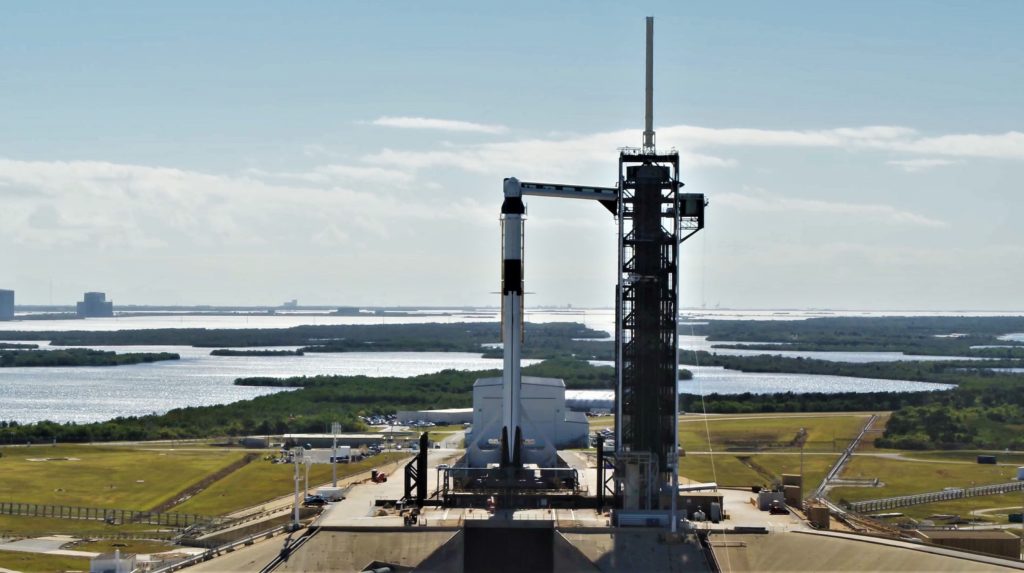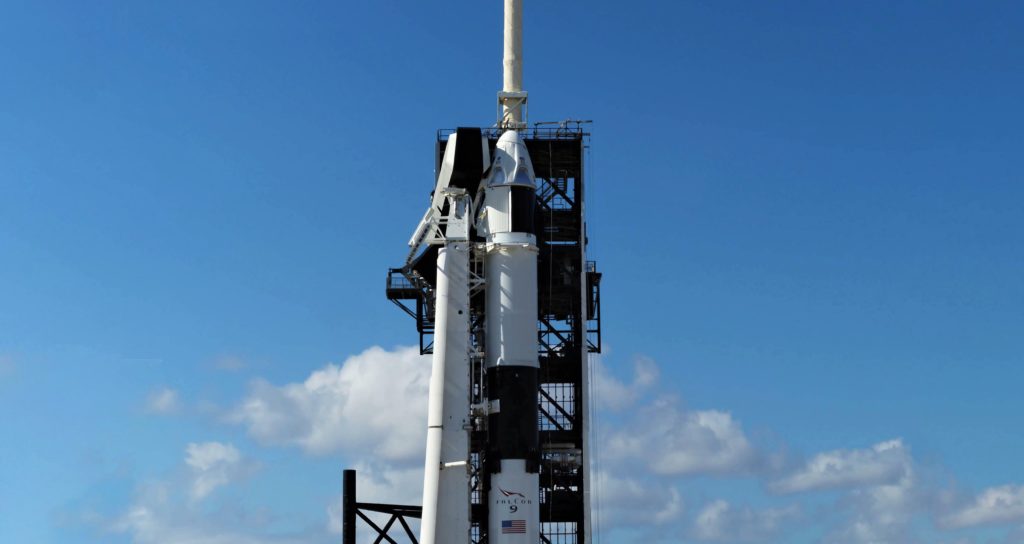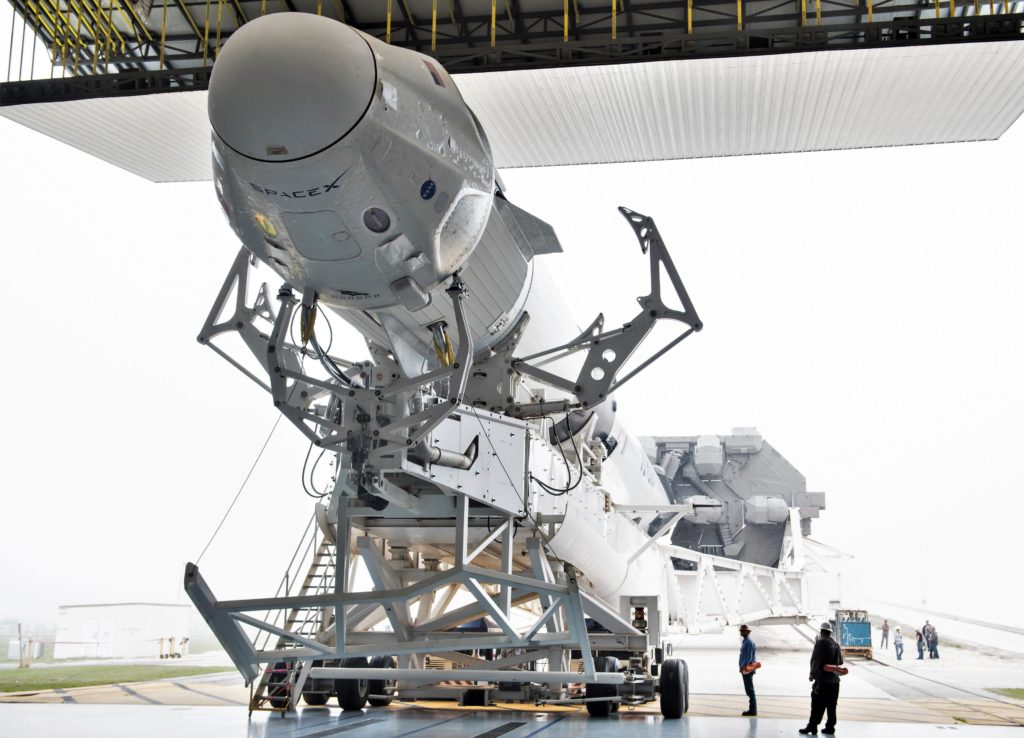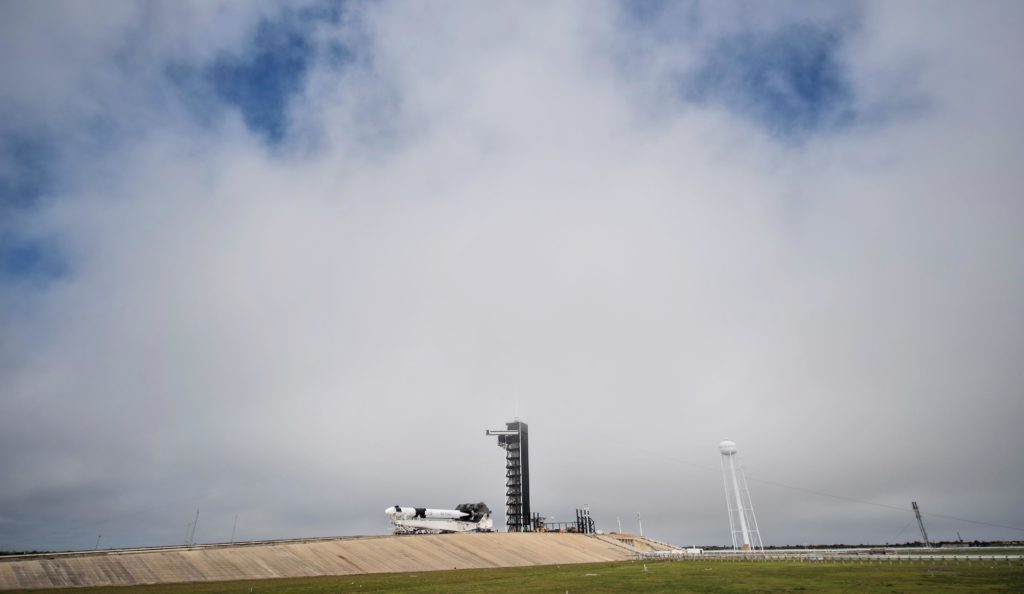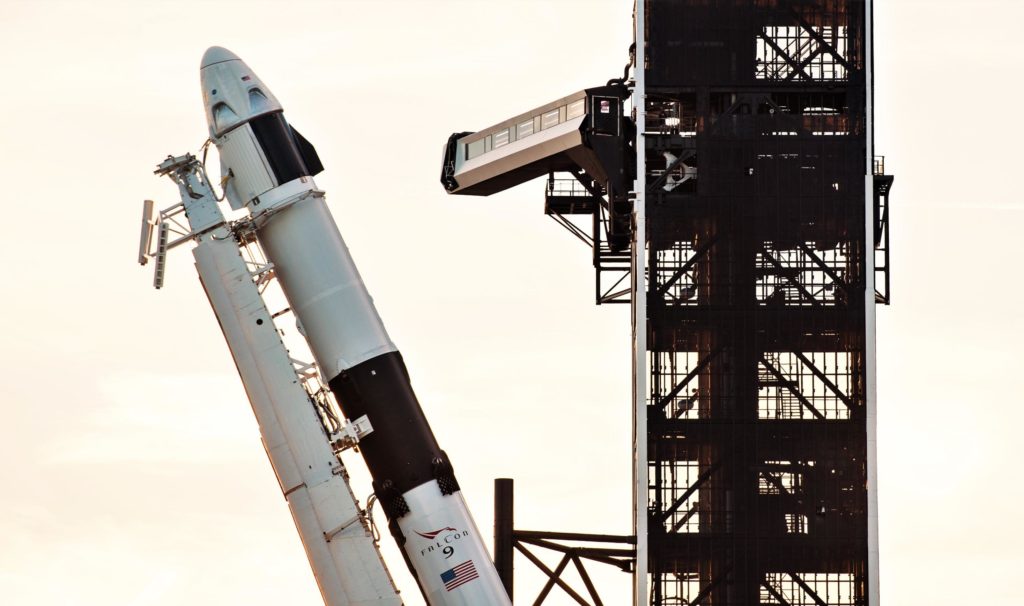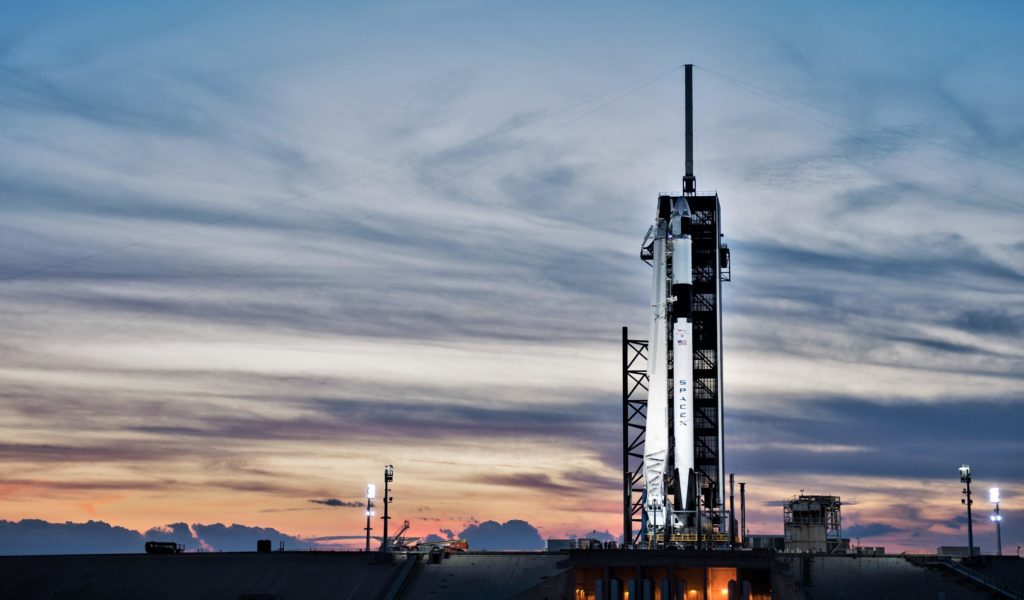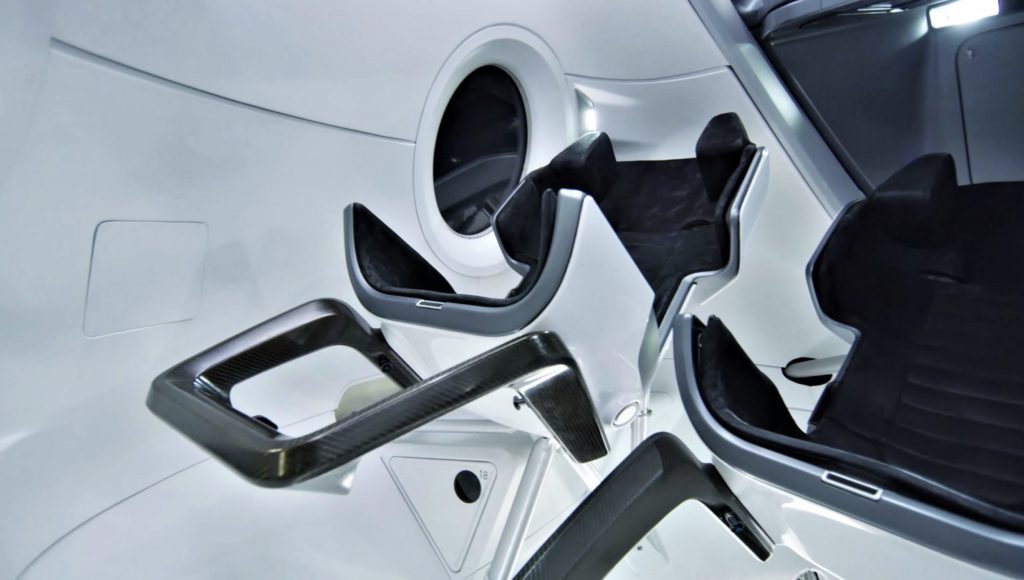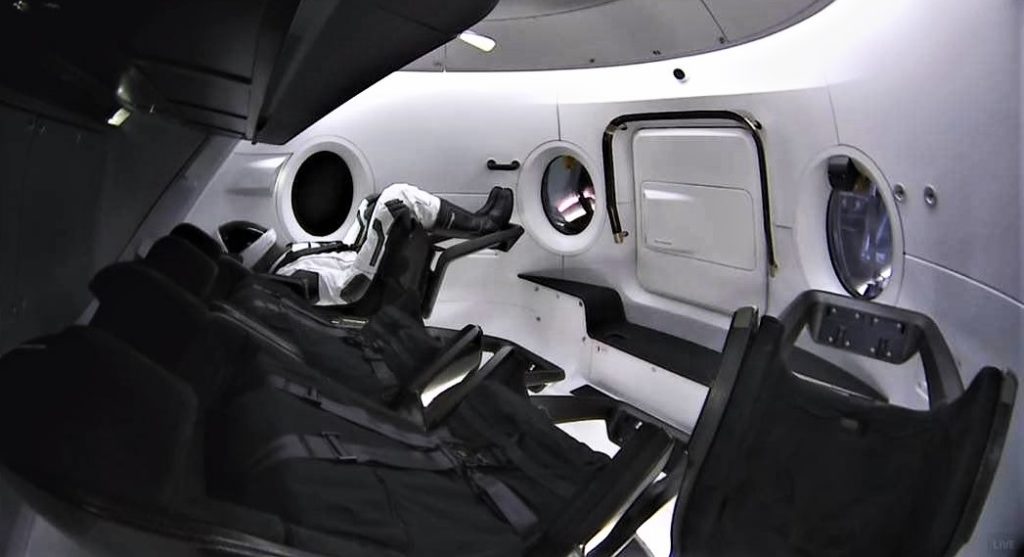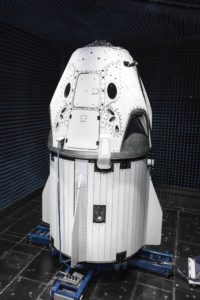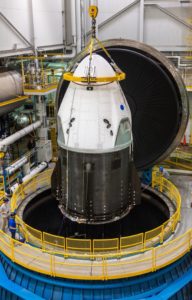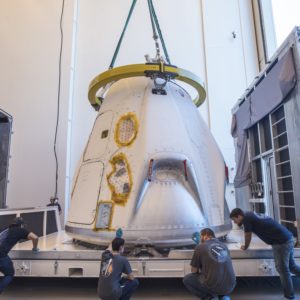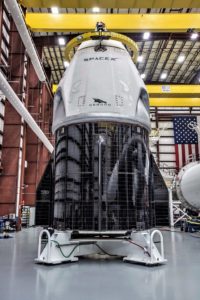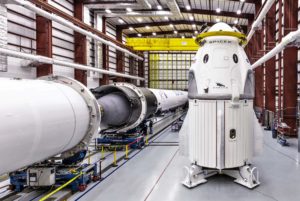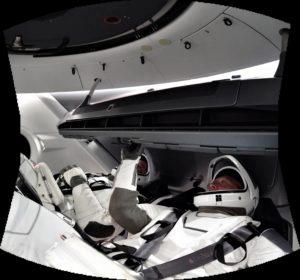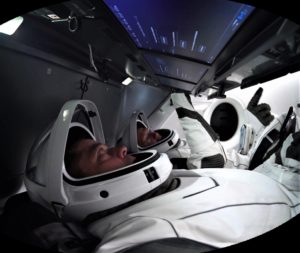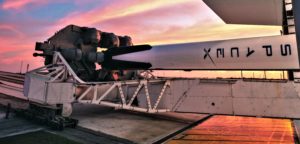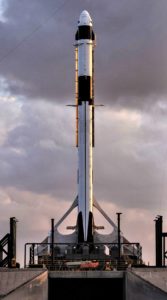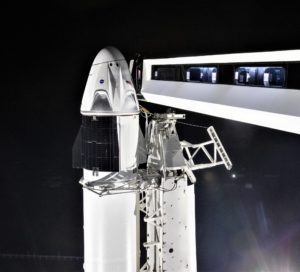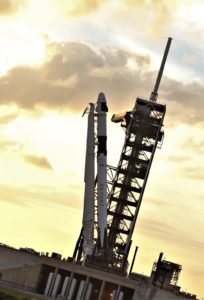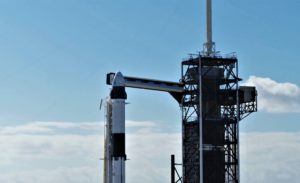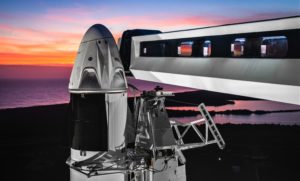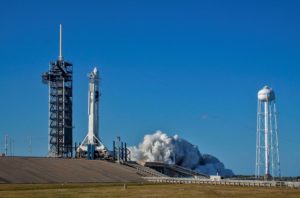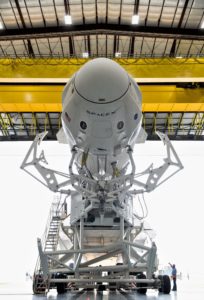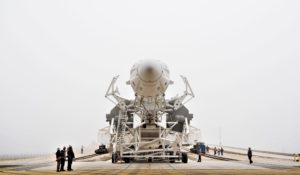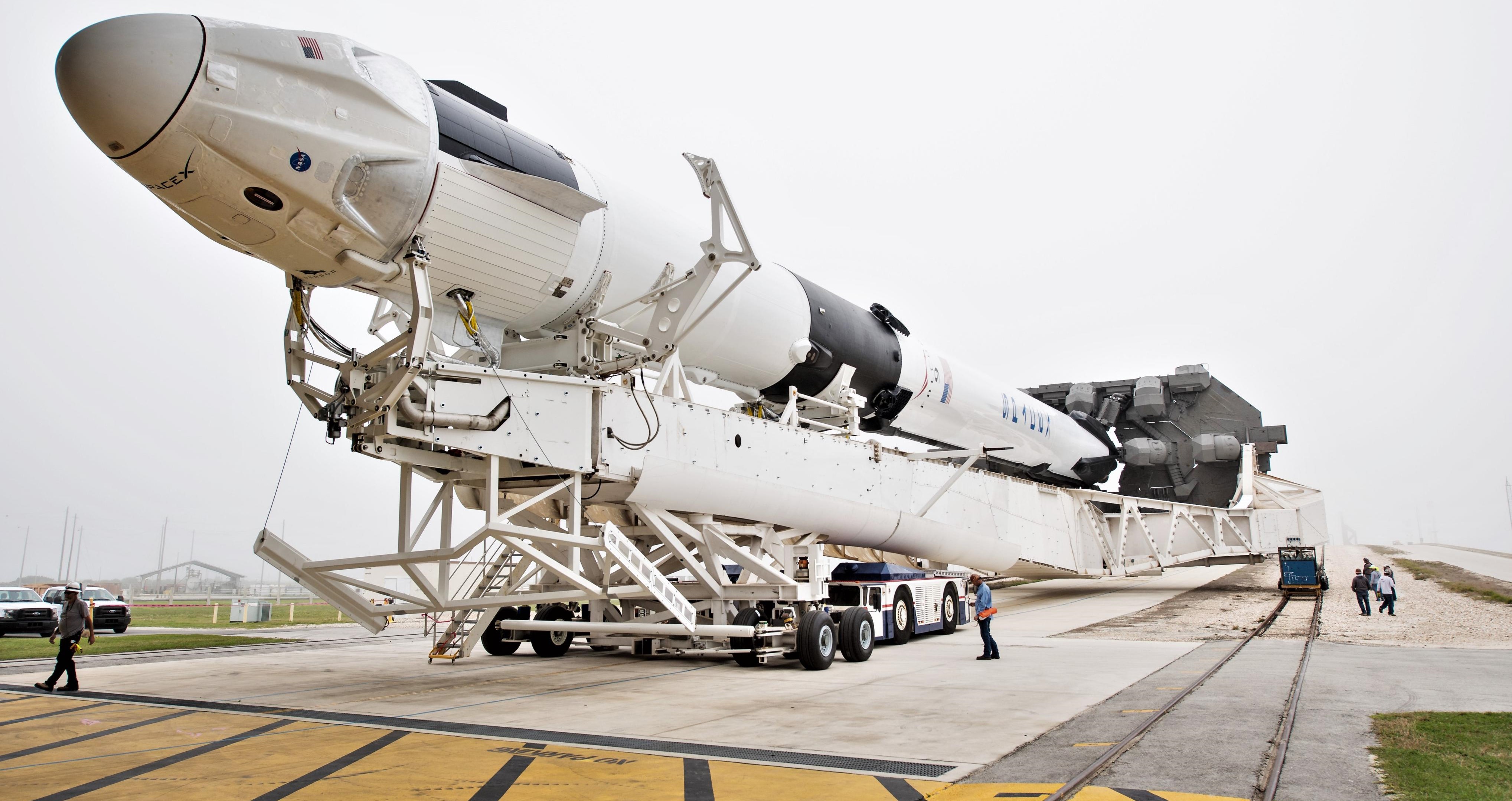

SpaceX
SpaceX’s space-bound Crew Dragon stars in spectacular preflight photos [gallery]
SpaceX and NASA are both participating in an exceptional media blitz on the verge of Crew Dragon’s orbital launch debut, sharing dozens of detailed photos and videos documenting the advanced spacecraft’s many years of development and its brief final voyage out to Launch Complex 39A (Pad 39A).
Scheduled to attempt its first launch at 2:48 am EST (07:48 UTC), March 2nd, CEO Elon Musk has already teased one significant part of a spectacular, hosted webcast SpaceX has prepared for the milestone launch, arguably the biggest step the company will have taken towards its foundational goal of “making humanity a multiplanetary species”. Riding along on the uncrewed demonstration mission will be a test dummy – Starwoman – known as Ripley, a close relative of the Starman character now orbiting the sun in deep space.
Crew Dragon and Falcon 9 rolled out to the launch pad ahead of the spacecraft’s first test flight. Liftoff targeted for 2:49 a.m. EST on March 2 pic.twitter.com/Dud93ZrkgH
— SpaceX (@SpaceX) February 28, 2019
Coming straight off of SpaceX’s February 21st Falcon 9 launch of commsat PSN-6 and Spaceflight’s GTO-1 rideshare, the contrast with the media presence behind Crew Dragon’s launch debut is stark. Regular SpaceX launches have grown into a routine distribution of official behind-the-scenes photos: one photo of Falcon 9 vertical on the pad after the rocket goes vertical, a hosted webcast with excellent live views of the mission, high-quality launch photos taken by SpaceX or contracted photographers, and – less frequently – a rare photo or two of the booster’s landing. NASA-led launches are a different story entirely, followed by USAF missions in a distant second place.
SpaceX and @NASA have completed thousands of hours of tests, analyses, and reviews in preparation for Crew Dragon’s first test flight to the @space_station pic.twitter.com/JvJqeoLKVy
— SpaceX (@SpaceX) February 28, 2019
Particularly so given that NASA has funded 99-100% of Crew Dragon’s costly development, SpaceX customers can typically reserve the right to request special views and even post photos of their own in launch or program contracts. As a civilian federal agency, NASA is largely obligated to share photos, insofar as they generally play nice with arms trafficking regulations like the US’ ITAR. For any number of reasons, SpaceX has become noticeably less keen on sharing photos of its milestones and more routine operations, regardless of whether or not a given subject is likely to raise the ire of ITAR.
While the company still shares far more than they technically have to (i.e. nothing), competitors like ULA tend to share far more even for extraordinarily security-conscious National Reconnaissance Office launches. Regardless of the company’s reasons, to which they have every right, the floodgates have been opened in the two or so months that have built up to Crew Dragon’s inaugural launch.
Ripley pic.twitter.com/Z9Ztram8Ai
— Elon Musk (@elonmusk) March 1, 2019
Combined, NASA and SpaceX have shared dozens of extremely high-quality photos of Falcon 9, Crew Dragon, and the general behind-the-scenes work required to make every launch (including this one) happen. SpaceX has also offered numerous rare glimpses into those processes, including rocket’s roll-out to Pad 39A and a brief 60-second overview featuring clips of much of the Crew Dragon development work that has been ongoing for 5+ years.
- Crew Dragon and Falcon 9 B1051 stand vertical at Pad 39A during preparations for a late January static fire test. (SpaceX)
- Crew Dragon and Falcon 9 B1051 stand vertical at Pad 39A during preparations for a late January static fire test. (SpaceX)
- Falcon 9 B1051 and Crew Dragon rolled out to Pad 39A on February 28th, roughly 60 hours before launch. (NASA)
- Falcon 9 B1051 and Crew Dragon rolled out to Pad 39A on February 28th, roughly 60 hours before launch. (NASA)
- A few hours later, Falcon 9 B1051 and Crew Dragon were lifted into the vertical position on SpaceX’s Transporter/Erector (T/E). (NASA)
- A SpaceX Falcon 9 rocket with the company’s Crew Dragon spacecraft onboard is seen after being raised into a vertical position on the launch pad at Launch Complex 39A as preparations continue for the Demo-1 mission, Feb. 28, 2019 at the Kennedy Space Center in Florida. The Demo-1 mission will be the first launch of a commercially built and operated American spacecraft and space system designed for humans as part of NASA’s Commercial Crew Program. The mission, currently targeted for a 2:49am launch on March 2, will serve as an end-to-end test of the system’s capabilities Photo Credit: (NASA/Joel Kowsky)
- A glimpse of Crew Dragon’s interior. (SpaceX)
- Starwoman – nicknamed Ripley – will be riding along on Crew Dragon’s debut launch. (SpaceX)
Onwards and upwards
Put simply, this mission may be the most important launch since SpaceX graduated from Falcon 1 to Falcon 9 almost nine years ago. Founded by Elon Musk with a single-minded purpose of creating cost-effective, reusable rockets that could allow or at least motivate humans to one day reach Mars, the pursuit of human spacecraft has been on the minds and agendas of Musk and SpaceX since the company’s 2002 formation. If Crew Dragon’s orbital debut is successful, SpaceX will have taken the biggest step yet in the direction of those lofty aspirations, thanks in large part to the funding and expertise bestowed upon the company through NASA’s Commercial Crew Program.
While SpaceX technically owns and operates it, Crew Dragon is a fundamentally NASA-owned vehicle with respect to fundamental capabilities and limitations baked into its design. The countless hundreds of thousands of hours of experience derived from developing Crew Dragon will, however, feed directly into Starship, a spacecraft that will very nearly be SpaceX’s and SpaceX’s alone, from a blank sheet of paper to Mars (fate permitting).
- The DM-1 Crew Dragon testing inside SpaceX’s anechoic chamber, May 2018. (SpaceX)
- SpaceX’s Demo Mission-1 Crew Dragon seen preparing for vacuum tests at a NASA-run facility, June 2018. (SpaceX)
- The first spaceworthy Crew Dragon capsule is already in Florida, preparing for its November 2018 launch debut. The same capsule will be refurbished and reflown as few as three months after recovery. (SpaceX)
- The first complete Crew Dragon is likely just days away from rolling out to Pad 39A atop Falcon 9. (SpaceX)
- An impressive view of Crew Dragon (DM-1), Falcon 9 B1051, and its upper stage. (SpaceX)
- DM-1 and Falcon 9 were greeted by an extraordinary – albeit mildly bittersweet – dawn during their first-ever trip out to Pad 39A. (SpaceX)
- Falcon 9 B1051 and Crew Dragon vertical at Pad 39A. (SpaceX)
- Crew Dragon shows off its conformal (i.e. curved) solar array while connected to SpaceX’s sleek Crew Access Arm (CAA). (SpaceX)
- Falcon 9 and Crew Dragon are raised vertical at Pad 39A ahead of a late January static fire test. (SpaceX)
- Crew Dragon and Falcon 9 B1051 stand vertical at Pad 39A during preparations for a late January static fire test. (SpaceX)
- Crew Dragon and Falcon 9 are ready for the spacecraft’s orbital launch debut, NET March 2nd. (SpaceX)
- SpaceX completed a successful static fire of the first Falcon 9 rated for human flight on January 24th. DM-1 is now NET March 2019. (SpaceX)
- Falcon 9 B1051 and Crew Dragon rolled out to Pad 39A on February 28th, roughly 60 hours before launch. (NASA)
- Falcon 9 B1051 and Crew Dragon rolled out to Pad 39A on February 28th, roughly 60 hours before launch. (NASA)
- Falcon 9 B1051 and Crew Dragon rolled out to Pad 39A on February 28th, roughly 60 hours before launch. (NASA)
- Falcon 9 B1051 and Crew Dragon rolled out to Pad 39A on February 28th, roughly 60 hours before launch. (NASA)
- Falcon 9 B1051 and Crew Dragon rollQDed out to Pad 39A on February 28th, roughly 60 hours before launch. (NASA)
- A few hours later, Falcon 9 B1051 and Crew Dragon were lifted into the vertical position on SpaceX’s Transporter/Erector (T/E). (NASA)
- A few hours later, Falcon 9 B1051 and Crew Dragon were lifted into the vertical position on SpaceX’s Transporter/Erector (T/E). (NASA)
- A few hours later, Falcon 9 B1051 and Crew Dragon were lifted into the vertical position on SpaceX’s Transporter/Erector (T/E). (NASA)
Check out Teslarati’s newsletters for prompt updates, on-the-ground perspectives, and unique glimpses of SpaceX’s rocket launch and recovery processes!
News
SpaceX launches Ax-4 mission to the ISS with international crew
The SpaceX Falcon 9 launched Axiom’s Ax-4 mission to ISS. Ax-4 crew will conduct 60+ science experiments during a 14-day stay on the ISS.
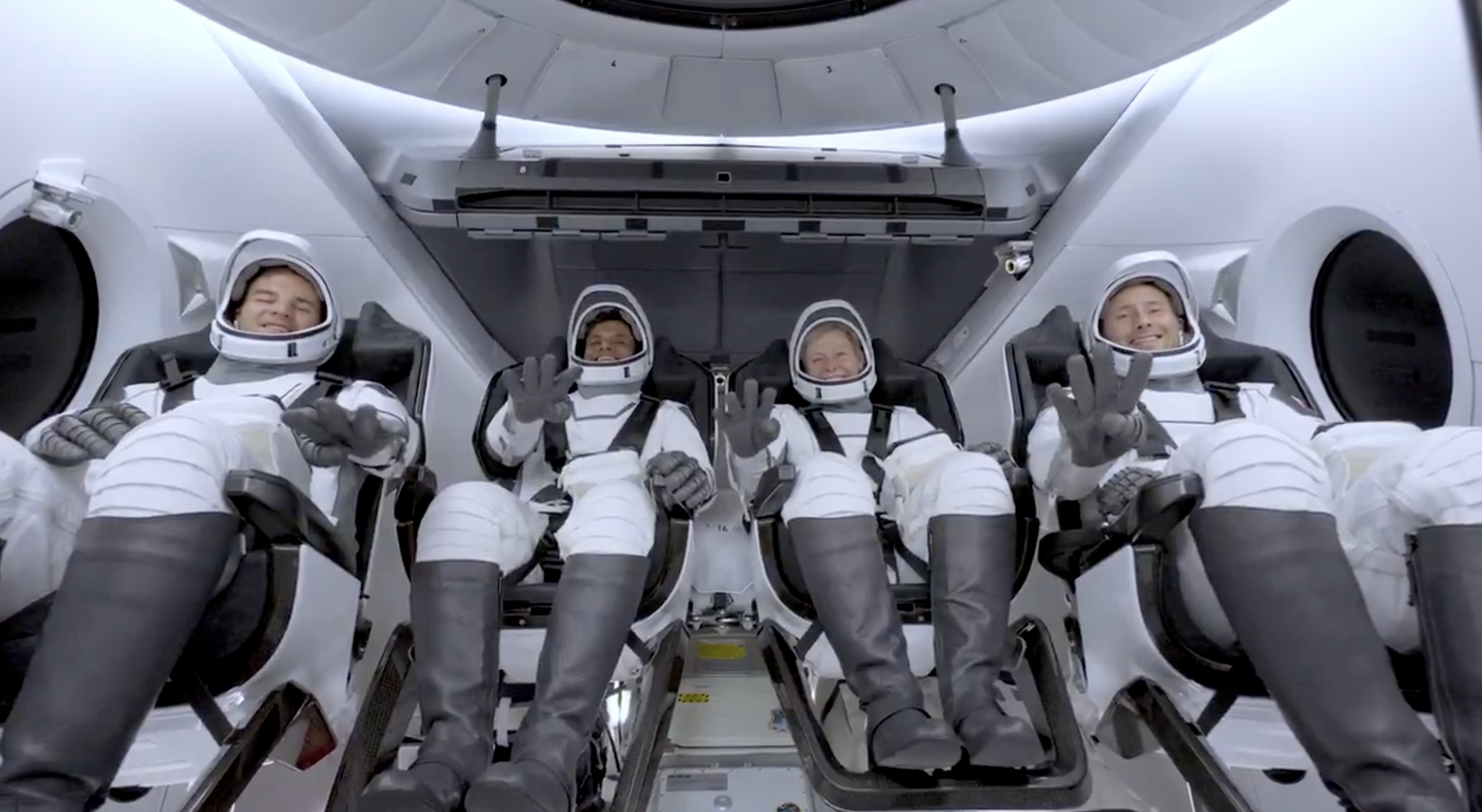
SpaceX launched the Falcon 9 rocket kickstarting Axiom Space’s Ax-4 mission to the International Space Station (ISS). Axiom’s Ax-4 mission is led by a historic international crew and lifted off from Kennedy Space Center’s Launch Complex 39A at 2:31 a.m. ET on June 25, 2025.
The Ax-4 crew is set to dock with the ISS around 7 a.m. ET on Thursday, June 26, 2025. Axiom Space, a Houston-based commercial space company, coordinated the mission with SpaceX for transportation and NASA for ISS access, with support from the European Space Agency and the astronauts’ governments.
The Ax-4 mission marks a milestone in global space collaboration. The Ax-4 crew, commanded by U.S. astronaut Peggy Whitson, includes Shubhanshu Shukla from India as the pilot, alongside mission specialists Sławosz Uznański-Wiśniewski from Poland and Tibor Kapu from Hungary.
“The trip marks the return to human spaceflight for those countries — their first government-sponsored flights in more than 40 years,” Axiom noted.
Shukla’s participation aligns with India’s Gaganyaan program planned for 2027. He is the first Indian astronaut to visit the ISS since Rakesh Sharma in 1984.
Axiom’s Ax-4 mission marks SpaceX’s 18th human spaceflight. The mission employs a Crew Dragon capsule atop a Falcon 9 rocket, designed with a launch escape system and “two-fault tolerant” for enhanced safety. The Axiom mission faced a few delays due to weather, a Falcon 9 leak, and an ISS Zvezda module leak investigation by NASA and Roscosmos before the recent successful launch.
As the crew prepares to execute its scientific objectives, SpaceX’s Ax-4 mission paves the way for a new era of inclusive space research, inspiring future generations and solidifying collaborative ties in the cosmos. During the Ax-4 crew’s 14-day stay in the ISS, the astronauts will conduct nearly 60 experiments.
“We’ll be conducting research that spans biology, material, and physical sciences as well as technology demonstrations,” said Whitson. “We’ll also be engaging with students around the world, sharing our experience and inspiring the next generation of explorers.”
SpaceX’s Ax-4 mission highlights Axiom’s role in advancing commercial spaceflight and fostering international partnerships. The mission strengthens global space exploration efforts by enabling historic spaceflight returns for India, Poland, and Hungary.
News
Starlink Cellular’s T-Mobile service to grow with third-party app data
From Oct 2025, T-Satellite will enable third-party apps in dead zones! WhatsApp, X, AccuWeather + more coming soon.

Starlink Cellular’s T-Mobile service will expand with third-party app data support starting in October, enhancing connectivity in cellular dead zones.
T-Mobile’s T-Satellite, supported by Starlink, launches officially on July 23. Following its launch, T-Mobile’s Starlink Cellular service will enable data access for third-party apps like WhatsApp, X, Google, Apple, AccuWeather, and AllTrails on October 1, 2025.
T-Mobile’s Starlink Cellular is currently in free beta. T-Satellite will add MMS support for Android phones on July 23, with iPhone support to follow. MMS support allows users to send images and audio clips alongside texts. By October, T-Mobile will extend emergency texting to all mobile users with compatible phones, beyond just T-Mobile customers, building on its existing 911 texting capability. The carrier also provides developer tools to help app makers integrate their software with T-Satellite’s data service, with plans to grow the supported app list.
T-Mobile announced these updates during an event celebrating an Ookla award naming it the best U.S. phone network, a remarkable turnaround from its last-place ranking a decade ago.
“We not only dream about going from worst to best, we actually do it. We’re a good two years ahead of Verizon and AT&T, and I believe that lead is going to grow,” said T-Mobile’s Chief Operating Officer Srini Gopalan.
T-Mobile unveiled two promotions for its Starlink Cellular services to attract new subscribers. A free DoorDash DashPass membership, valued at $10/month, will be included with popular plans like Experience Beyond and Experience More, offering reduced delivery and service fees. Meanwhile, the Easy Upgrade promotion targets Verizon customers by paying off their phone balances and providing flagship devices like the iPhone 16, Galaxy S25, or Pixel 9.
T-Mobile’s collaboration with SpaceX’s Starlink Cellular leverages orbiting satellites to deliver connectivity where traditional networks fail, particularly in remote areas. Supporting third-party apps underscores T-Mobile’s commitment to enhancing user experiences through innovative partnerships. As T-Satellite’s capabilities grow, including broader app integration and emergency access, T-Mobile is poised to strengthen its lead in the U.S. wireless market.
By combining Starlink’s satellite technology with strategic promotions, T-Mobile is redefining mobile connectivity. The upcoming third-party app data support and official T-Satellite launch mark a significant step toward seamless communication, positioning T-Mobile as a trailblazer in next-generation wireless services.
News
Starlink expansion into Vietnam targets the healthcare sector
Starlink aims to deliver reliable internet to Vietnam’s remote clinics, enabling telehealth and data sharing.

SpaceX’s Starlink expansion into Vietnam targets its healthcare sector. Through Starlink, SpaceX seeks to drive digital transformation in Vietnam.
On June 18, a SpaceX delegation met with Vietnam’s Ministry of Health (MoH) in Hanoi. SpaceX’s delegation was led by Andrew Matlock, Director of Enterprise Sales, and the discussions focused on enhancing connectivity for hospitals and clinics in Vietnam’s remote areas.
Deputy Minister of Health (MoH) Tran Van Thuan emphasized collaboration between SpaceX and Vietnam. Tran stated: “SpaceX should cooperate with the MoH to ensure all hospitals and clinics in remote areas are connected to the StarLink satellite system and share information, plans, and the issues discussed by members of the MoH. The ministry is also ready to provide information and send staff to work with the corporation.”
The MoH assigned its Department of Science, Technology, and Training to work with SpaceX. Starlink Vietnam will also receive support from Vietnam’s Department of International Cooperation. Starlink Vietnam’s agenda includes improving internet connectivity for remote healthcare facilities, developing digital infrastructure for health examinations and remote consultations, and enhancing operational systems.
Vietnam’s health sector is prioritizing IT and digital transformation, focusing on electronic health records, data centers, and remote medical services. However, challenges persist in deploying IT solutions in remote regions, prompting Vietnam to seek partnerships like SpaceX’s.
SpaceX’s Starlink has a proven track record in healthcare. In Rwanda, its services supported 40 health centers, earning praise for improving operations. Similarly, Starlink enabled remote consultations at the UAE’s Emirati field hospital in Gaza, streamlining communication for complex medical cases. These successes highlight Starlink’s potential to transform Vietnam’s healthcare landscape.
On May 20, SpaceX met with Vietnam’s Ministry of Industry and Trade, announcing a $1.5 billion investment to provide broadband internet, particularly in remote, border, and island areas. The first phase includes building 10-15 ground stations across the country. This infrastructure will support Starlink’s healthcare initiatives by ensuring reliable connectivity.
Starlink’s expansion in Vietnam aligns with the country’s push for digital transformation, as outlined by the MoH. By leveraging its satellite internet expertise, SpaceX aims to bridge connectivity gaps, enabling advanced healthcare services in underserved regions. This collaboration could redefine Vietnam’s healthcare infrastructure, positioning Starlink as a key player in the nation’s digital future.
-

 Elon Musk1 week ago
Elon Musk1 week agoTesla investors will be shocked by Jim Cramer’s latest assessment
-

 News2 weeks ago
News2 weeks agoTesla Robotaxi’s biggest challenge seems to be this one thing
-

 News2 weeks ago
News2 weeks agoWatch the first true Tesla Robotaxi intervention by safety monitor
-

 Elon Musk2 weeks ago
Elon Musk2 weeks agoA Tesla just delivered itself to a customer autonomously, Elon Musk confirms
-

 News2 weeks ago
News2 weeks agoTesla Robotaxi rollout proves that Elon Musk still delivers, even if it’s late
-

 Elon Musk2 weeks ago
Elon Musk2 weeks agoxAI welcomes Memphis pollution results, environmental groups push back
-
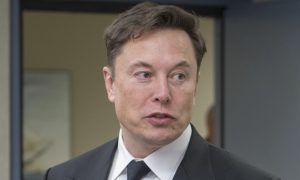
 Elon Musk2 weeks ago
Elon Musk2 weeks agoElon Musk commends Tesla team on successful Robotaxi launch
-

 Elon Musk2 weeks ago
Elon Musk2 weeks agoElon Musk confirms Tesla Optimus V3 already uses Grok voice AI

